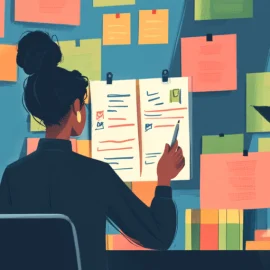

This article is an excerpt from the Shortform book guide to "The Pumpkin Plan" by Mike Michalowicz. Shortform has the world's best summaries and analyses of books you should be reading.
Like this article? Sign up for a free trial here.
What makes a customer bad? Can you get rid of customers that are doing more harm than good?
Mike Michalowicz says you need to fire bad customers because they can harm your business by wasting time and resources. Bad customers don’t share your values, aren’t financially trustworthy, and aren’t cooperative.
Keep reading to learn how to fire a customer and cut ties with them once and for all.
Getting Rid of Bad Customers
Many entrepreneurs struggle with learning how to fire a customer because they don’t want to lose any customers. However, these types of customers actually damage your business: They drain resources, leaving you less time, energy, and funding to devote to your valuable customers who’ll actually help you succeed. By firing these customers—and eliminating the expenses associated with them—you give yourself room to better serve your remaining ones. As discussed, this better service will then attract more valuable customers, helping your company grow.
(Shortform note: In Profit First, Michalowicz goes into more detail about the damage bad customers can do to your company. He cites a study that found the top 25% of customers bring in 150% of your company’s profit, the middle 50% break even, and the bottom 25% cost you 50% of your profit. In other words, if you fire those worst customers, you could reduce your expenses and increase profit by 50%, even though you “lost” a quarter of your customer base.)
Michalowicz recommends re-ranking your customers every quarter. This ensures you catch any new bad customers before they can cause much damage. It could also help you decide which mediocre customers to fire when making room for more valuable ones. (Shortform note: Another potential benefit of re-ranking your customers every quarter is noticing changes in your valuable ones. Your customers may outgrow your company, Jason Fried and David Heinemeier Hansson explain in Rework. Instead of changing your products or services to retain those once-valuable customers, focus on attracting new ones that better align with you.)
How to Fire Customers
One method Michalowicz offers for firing customers is eliminating products or services that your worst customers use but your best customers don’t. Once you cut these products or services, the bad customers will likely leave, while the valuable and most valuable customers won’t care. Another benefit of this method is that cutting these products or services will give you more resources to pour into the products or services your best customers do use, making them happier and therefore more valuable.
(Shortform note: Before you eliminate a product or service, it may help to have potential customers lined up for your other products or services. Some business experts say having a way to replace the revenue you’ll lose when a bad customer leaves can give you the confidence to fire them. It helps you focus on the opportunities you’ll have once they’re gone—like using your freed resources to provide your other products or services to more people. Another way you could motivate yourself is by determining whether the products only used by bad customers are underperforming. Underperforming products drain resources, like bad customers, and knowing that you’ll save money in two areas may help you finalize your decision.)
Michalowicz also offers a more direct method: Tell the customer that you can no longer serve them, and offer a reason why. He suggests using the excuse that you made an agreement with another customer, and you have to focus on fulfilling it. You don’t actually need to have an agreement, he says, implying that simply giving a reason helps the firing process go smoothly. If you’re going to name a specific customer in your excuse, though, you should get approval from them first.
(Shortform note: Some business experts say that firing customers directly is the best method, as it shows empathy and respect for the customer. While they agree that you should explain why you can no longer serve the customer, they emphasize the importance of being honest about those reasons. Before firing the customer, walk back through their record and determine exactly what the problems were and how you tried to address them. Presenting these facts to the customer can help you be firm about your decision and stop them from arguing. In addition, this process confirms that you’ve exhausted your other options and firing them is the best option.)

———End of Preview———
Like what you just read? Read the rest of the world's best book summary and analysis of Mike Michalowicz's "The Pumpkin Plan" at Shortform.
Here's what you'll find in our full The Pumpkin Plan summary:
- Why you’re struggling as an entrepreneur
- What business leaders can learn from prize-winning pumpkin farmers
- The power of focusing on quality rather than quantity






